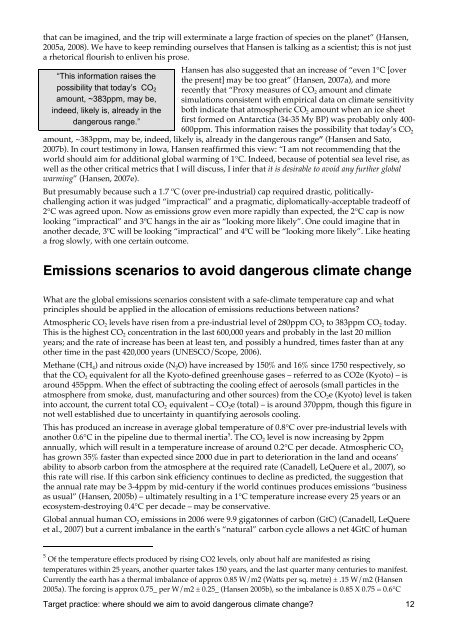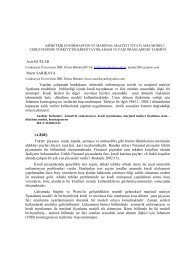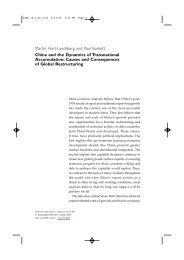The shift in the pragmatic goal is plain in the 2007 IPCC Working Group III report. Of the 177research scenarios assessed for future emissions profiles, only six dealt with limiting the rise <strong>to</strong> therange of 2–2.4ºC. By contrast, 118 covered the range of 3.2–4ºC, which suggest that the IPCCscientists, following the lead of the politicians, have also largely shifted focus from 2ºC (IPCC, 2007c:22).This whole dialogue about 450ppm or 550pmm, 2ºC or 3ºC needs <strong>to</strong> be considered from anotherperspective. The Stern considerations are wholly dependent on the assumption that <strong>climate</strong>sensitivity – the equilibrium rise in temperature for a doubling of CO 2 from 280ppm <strong>to</strong> 560ppm – isaround 3ºC. But this is true when only fast feedbacks are considered and the long-term sensitivity isin fact 6ºC (Hansen and Sa<strong>to</strong>, 2007b), reaffirmed in Hansen’s testimony in the Iowa coal case: “Thishigher <strong>climate</strong> sensitivity, 6°C for doubled CO 2 , is the appropriate sensitivity for long time scales,when greenhouse gases are the specified forcing mechanism and all other slow feedbacks are allo<strong>we</strong>d<strong>to</strong> fully respond <strong>to</strong> the <strong>climate</strong> <strong>change</strong>” (Hansen, 2007e).To be utterly clear, a doubling of CO 2 levels will in the end produce a 6°C increase; Stern’s 550ppmtarget is a 6°C increase; contemplating a 550ppm policy target for Australia is setting an equilibriumtemperature rise of 6°C as policy. And <strong>we</strong> know that “the last time the planet was 5°C warmer, justprior <strong>to</strong> the glaciation of Antarctica about 35 million years ago, there <strong>we</strong>re no large ice sheets on theplanet. Given <strong>to</strong>day’s ocean basins, if the ice sheets melt entirely, sea level will rise about 70 meters”(Hansen, 2007e).In peer-revie<strong>we</strong>d research published in “Nature”, it was demonstrated that it is likely that when CO 2exceeds 500ppm, the global temperature suddenly rises 6°C and becomes stable again despite furtherincreases or decreases of atmospheric CO 2 (Lovelock and Kump, 1994). This contrasts with the IPCCmodels that predict that temperature rises and falls smoothly with increasing or decreasing CO 2 .Explaining the research, Lovelock points out that as the ocean surface temperature warms <strong>to</strong> over12°C, "a stable layer of warm water forms on the surface that stays unmixed with the cooler, nutrientrichwaters below. This purely physical property of ocean water denies nutrients <strong>to</strong> the life in thewarm layer, and soon the upper sunlit ocean water becomes a desert", recognized by the clear azureblue, dead water of most of <strong>to</strong>day's ocean surface. In such nutrient-deprived water, ocean life cannotprosper and soon "the surface layer is empty of all but a limited and starving population of algae".Algae, which comprise most of the ocean's plant life, are the world's greatest CO 2 sink, pumpingdown CO 2 , as <strong>we</strong>ll as contributing <strong>to</strong> cloud cover by releasing dimethyl sulphide DMS in<strong>to</strong> theatmosphere, a gas connected with the formation of clouds and with <strong>climate</strong>, so that warmer seas andless algae will likely reduce cloud formation and further enhance positive feedback. Lovelock sayssevere disruption of the algae/DMS relation would signal spiralling and irreversible <strong>climate</strong> <strong>change</strong>.Algae prosper in waters below 10°C, so as the <strong>climate</strong> warms, the algae population reduces. Themodelling of <strong>climate</strong> warming and regulation by Lovelock and Kump suggests that "as the CO 2abundance approached 500ppm, regulation began <strong>to</strong> fail and there was a sudden upward jump intemperature. The cause was the failure of the ocean ecosystem. As the world grew warmer, the algae<strong>we</strong>re denied nutrients by the expanding warms surface of the oceans, until eventually they becameextinct. As the area of ocean covered by algae grew smaller, their cooling effect diminished and thetemperature surged upwards." The end result was a temperature rise of 8°C above pre-industriallevels, which would result in the planet being habitable only from the latitude of Melbourne south <strong>to</strong>the south pole, and northern Europe, Asia and Canada <strong>to</strong> the north pole (Lovelock, 2006).So just as events on the ground compel us <strong>to</strong> conclude that the cap needs <strong>to</strong> be substantially less than1ºC, <strong>we</strong> are now getting the third degree (in reality, the sixth degree) as 2ºC fades as a supposedly“unrealistic” compromise. Policy and goal-setting seem precariously <strong>we</strong>dged bet<strong>we</strong>en scientific needand political “reality”, an ambivalence keenly expressed in Stern's work.The established science long ago demanded a cap <strong>we</strong>ll below 2°C <strong>to</strong> avoid <strong>dangerous</strong> impacts. JamesHansen – before the Arctic summer of 2007 which will likely cause a further revision downward inhis work – pointed <strong>to</strong> the need for a cap that was a safe amount less than 1.7°C: “Earth’s positive energyimbalance is now continuous, relentless and growing… global warming of more than one degreeCelsius above <strong>to</strong>day’s global temperature [of 0.7°C] would likely constitute ‘<strong>dangerous</strong> anthropogenicinterference’ with <strong>climate</strong>… This warming has brought us <strong>to</strong> the precipice of a great ‘tipping point’. If<strong>we</strong> go over the edge, it will be a transition <strong>to</strong> ‘a different planet’, an environment far outside the rangethat has been experienced by humanity. There will be no return within the lifetime of any generationTarget practice: <strong>where</strong> <strong>should</strong> <strong>we</strong> <strong>aim</strong> <strong>to</strong> avoid <strong>dangerous</strong> <strong>climate</strong> <strong>change</strong>? 11
that can be imagined, and the trip will exterminate a large fraction of species on the planet” (Hansen,2005a, 2008). We have <strong>to</strong> keep reminding ourselves that Hansen is talking as a scientist; this is not justa rhe<strong>to</strong>rical flourish <strong>to</strong> enliven his prose.“This information raises thepossibility that <strong>to</strong>day’s CO 2amount, ~383ppm, may be,indeed, likely is, already in the<strong>dangerous</strong> range.”Hansen has also suggested that an increase of “even 1°C [overthe present] may be <strong>to</strong>o great” (Hansen, 2007a), and morerecently that “Proxy measures of CO 2 amount and <strong>climate</strong>simulations consistent with empirical data on <strong>climate</strong> sensitivityboth indicate that atmospheric CO 2 amount when an ice sheetfirst formed on Antarctica (34-35 My BP) was probably only 400-600ppm. This information raises the possibility that <strong>to</strong>day’s CO 2amount, ~383ppm, may be, indeed, likely is, already in the <strong>dangerous</strong> range” (Hansen and Sa<strong>to</strong>,2007b). In court testimony in Iowa, Hansen reaffirmed this view: “I am not recommending that theworld <strong>should</strong> <strong>aim</strong> for additional global warming of 1°C. Indeed, because of potential sea level rise, as<strong>we</strong>ll as the other critical metrics that I will discuss, I infer that it is desirable <strong>to</strong> avoid any further globalwarming” (Hansen, 2007e).But presumably because such a 1.7 ºC (over pre-industrial) cap required drastic, politicallychallengingaction it was judged “impractical” and a pragmatic, diplomatically-acceptable tradeoff of2°C was agreed upon. Now as emissions grow even more rapidly than expected, the 2°C cap is nowlooking “impractical” and 3ºC hangs in the air as “looking more likely”. One could imagine that inanother decade, 3ºC will be looking “impractical” and 4ºC will be “looking more likely”. Like heatinga frog slowly, with one certain outcome.Emissions scenarios <strong>to</strong> avoid <strong>dangerous</strong> <strong>climate</strong> <strong>change</strong>What are the global emissions scenarios consistent with a safe-<strong>climate</strong> temperature cap and whatprinciples <strong>should</strong> be applied in the allocation of emissions reductions bet<strong>we</strong>en nations?Atmospheric CO 2 levels have risen from a pre-industrial level of 280ppm CO 2 <strong>to</strong> 383ppm CO 2 <strong>to</strong>day.This is the highest CO 2 concentration in the last 600,000 years and probably in the last 20 millionyears; and the rate of increase has been at least ten, and possibly a hundred, times faster than at anyother time in the past 420,000 years (UNESCO/Scope, 2006).Methane (CH 4 ) and nitrous oxide (N 2 O) have increased by 150% and 16% since 1750 respectively, sothat the CO 2 equivalent for all the Kyo<strong>to</strong>-defined greenhouse gases – referred <strong>to</strong> as CO2e (Kyo<strong>to</strong>) – isaround 455ppm. When the effect of subtracting the cooling effect of aerosols (small particles in theatmosphere from smoke, dust, manufacturing and other sources) from the CO 2 e (Kyo<strong>to</strong>) level is takenin<strong>to</strong> account, the current <strong>to</strong>tal CO 2 equivalent – CO 2 e (<strong>to</strong>tal) – is around 370ppm, though this figure innot <strong>we</strong>ll established due <strong>to</strong> uncertainty in quantifying aerosols cooling.This has produced an increase in average global temperature of 0.8°C over pre-industrial levels withanother 0.6°C in the pipeline due <strong>to</strong> thermal inertia 5 . The CO 2 level is now increasing by 2ppmannually, which will result in a temperature increase of around 0.2°C per decade. Atmospheric CO 2has grown 35% faster than expected since 2000 due in part <strong>to</strong> deterioration in the land and oceans’ability <strong>to</strong> absorb carbon from the atmosphere at the required rate (Canadell, LeQuere et al., 2007), sothis rate will rise. If this carbon sink efficiency continues <strong>to</strong> decline as predicted, the suggestion thatthe annual rate may be 3-4ppm by mid-century if the world continues produces emissions “businessas usual” (Hansen, 2005b) – ultimately resulting in a 1°C temperature increase every 25 years or anecosystem-destroying 0.4°C per decade – may be conservative.Global annual human CO 2 emissions in 2006 <strong>we</strong>re 9.9 giga<strong>to</strong>nnes of carbon (GtC) (Canadell, LeQuereet al., 2007) but a current imbalance in the earth's “natural” carbon cycle allows a net 4GtC of human5 Of the temperature effects produced by rising CO2 levels, only about half are manifested as risingtemperatures within 25 years, another quarter takes 150 years, and the last quarter many centuries <strong>to</strong> manifest.Currently the earth has a thermal imbalance of approx 0.85 W/m2 (Watts per sq. metre) ± .15 W/m2 (Hansen2005a). The forcing is approx 0.75_ per W/m2 ± 0.25_ (Hansen 2005b), so the imbalance is 0.85 X 0.75 = 0.6°CTarget practice: <strong>where</strong> <strong>should</strong> <strong>we</strong> <strong>aim</strong> <strong>to</strong> avoid <strong>dangerous</strong> <strong>climate</strong> <strong>change</strong>? 12





